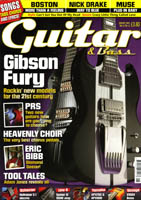Lollar Pickups: The Coolest Coils Around
We've come a long way from the first overpowered drop-in replacement pickups, and the latest name to hit the big time is that of Jason Lollar. Huw Price grabs a screwdriver and a soldering iron and heads for the basement.
Until fairly recently, Jason Lollar's pickups were a well-kept secret amongst the more choosy of American guitarists. You can't keep these things quiet forever, though, and now, after a long wait, Lollar pickups  are now available in the UK—so we've got the chance to find out what all the fuss is all about.
are now available in the UK—so we've got the chance to find out what all the fuss is all about.
I first heard about Jason Lollar a couple of years ago, while researching a Guitar & Bass article about winding your own pickups. Jason's Basic Pickup Winding—A Complete Guide to Making Your Own Pickup Winding Machine has achieved cult status, spawning a cottage industry of DIY pickup makers. All Lollar's single coils are scatter-wound, and the magnet strength is carefully treated to achieve the right tonal characteristics. In addition to making pickups, Lollar builds archtop, solidbody and lap steel guitars, and plays guitar and Hammond B3 with various local musicians on his island home outside of Seattle, Washington.
VINTAGE T SERIES SET
These pickups were installed in a Dearnaley Taff Delta with a swamp ash body and a one-piece maple neck. Jason Lollar's Vintage T Series are designed to produce a vintage-spec tone with a touch more output and a fuller midrange and bass. The Alnico V slugs are installed flush, early '50s style; cloth braided hook-up wire is used on both, and the neck pickup has a chrome-plated nickel silver cover
SOUNDS
The Lollars sound bright with plenty of detail, but where they really show class is in their total lack of harshness or any metallic quality. The bridge departs from the conventional Fender Telecaster sound by having a throatier thump, with real substance. There's no shortage of twang, but it all comes with an extra dash of solidity on the wound strings. The neck pickup is refined, with the strong woody flavour of the Taff Delta coming through.
Anyone who say they dislike Tele neck pickups simply hasn't heard a good one—or they haven't adjusted the one they have to the optimum height. Both these Lollar pickups sustain superbly and deliver all the classic T-type tones rockers and hardcore country boys could hope for. They're happy in clean and dirty mode, providing precise focus and dynamics and just a little extra fatness and grunt.
IMPERIAL HUMBUCKER SET
Most players expect fat, ballsy tones from this style of pickup but, in reality, Gibson's fabled PAFs from the late 1950s didn't really sound that way. Gibson's core customers during that era were jazz guitarists who wanted ware, hum-free clean tones, so the coils weren't overwound for stunt guitar heroics and the magnets were weaker for a refined high end.
It's exactly the same picture with the Lollar Imperials. They're wax-potted but there's still a hint of microphony if you tap the covers. Lollar uses graded Alnico 5 magnets and nickel silver or chrome pickup covers, and they are coil tappable. The website advertises "aged" and "heavily aged" covers for an extra $15—which isn't a bad deal when compared to Duncan Antiquities.
SOUNDS
The Imperial is my kind of humbucker; output levels are low, and the treble content is high. The transient response is also very fast, so there's plenty of snap—almost comparable to a single coil-type attack. Our Les Paul through a Vox AC10 sounded wonderfully open and responsive with a fine balance between the two units. Imperials would really suit retro-style players chasing a bluesy or jazzy humbucker tone that's just hot enough to drive an amp without danger of mushing out.
VINTAGE BLACKFACE STRATOCASTER SET
And finally, the acid test; a set of three matched Lollars for a Fender Strat. The bridge unit has been given a few extra turns to avoid any anaemic quality—but not enough, we hope, to ruin its character. The middle pickup has reverse windings and reverse polarity, so the "in between" settings are humbucking (you can't mix them up because the middle pickup has yellow and black cloth-covered cable, not black and white.) The polepieces are unstaggered because Lollar believes this produces more balanced tone.
SOUNDS
I have to admit, I could hardly stop playing long enough to write this review. These Lollars combine spectral transparency with the sweetest harmonics, and each pickup has its own distinct tone. The bridge unit has punch and weight on the wound strings with no sacrifice of snap and bite; the middle one has a fatter tone due to it's position, but it's clearer because it has fewer windings. The "in between" setting is pure early Knopfler, and the clarity is retained even when you turn down the guitar volume. The neck pickup sounds huge, with fat rounded lows and shimmering highs. In addition, all three pickups seem to produce unusual quantities of sustain even through a clean amp. As if that wasn't enough, you get all the woody tone of the guitar too. Superb!
VERDICT
Pickups are not the quick route to sonic Nirvana: they're merely a part of the puzzle. In some quarters Jason Lollar pickups have been hailed as some kind of Holy Grail: in reality, they're simply primo-quality handmade pickups. But let's not damn them with faint praise. No doubt, they will out-perform most factory pickups and aftermarket replacements for transparency, smooth high-frequency response and dynamics. If you guitar sounds great acoustically but something goes missing by the time it hits your amp, it's an ideal candidate for a pickup upgrade. The market is crowded with boutique pickups, but some brands still stand out—and Lollar is one of them.